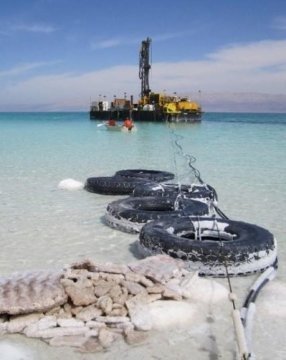[ad_1]
Studying organic matter in sediments helps shed light on the distant past. What was the climate like? What organisms populated the Earth? What conditions did they live in? Researchers from the University of Geneva (UNIGE), Switzerland, and the University of Lyon, France, have examined the sediments in the Dead Sea, where the salinity is without compare, making it one of the most hostile environments on the planet. The geologists drilled a 400-metre hole in the core of the Dead Sea before analysing each layer of sediment and the traces of a strategy that enables bacteria to survive by feeding on the remains of other organisms. This discovery, to be read about in the journal Geology, will further our understanding of how life can develop even in the most severe conditions. It also provides vital research leads for detecting life on other planets.
The study of the deep biosphere — microbial presence in sediments — helps us understand the various aspects of the evolution of the Earth and the manifold climatic changes that it has been subjected to. “”t’s about studying bacteria and archaea — the oldest forms of life on Earth — that live in the sediments, and analysing the transformation processes that result from their presence, and that’s called diagenesis,” explains Daniel Ariztegui, a professor in the Department of Earth Sciences in UNIGE Faculty of Sciences.
An international team worked on reconstructing the climate of the Dead Sea over the last 200,000 years. Although the surface area of the lake and its depth are roughly equivalent to those of Lake Geneva, the Dead Sea loses a metre a year, which explains its ever-increasing salinity: 275 grams of salt per litre compared to 20 to 40 grams per litre in the oceans. Nevertheless, microbial life subsists in this extreme environment. But is it possible that a form of life has managed to adapt to the sediments in the Dead Sea — a particularly hostile environment that is isolated from the surface without any light, oxygen or frequent food intake? The scientists drilled a hole 400 metres deep and 10 centimetres in diameter in the heart of the Dead Sea in an attempt to find traces of microbial presence in the sediments, analysing sediment samples for each metre that was dug.
Necrophilous bacteria
“We started by freezing the collected samples to preserve any genetic material that might degrade at room temperature,” explains Dr Camille Thomas, a researcher in UNIGE Department of Earth Sciences. “Then we used different techniques, including scanning electron microscopy, which can identify at very high resolution the remains of microbes that could have changed the original composition of the sediments.” The aim was also to extract the organic compounds trapped in the salt, such as DNA or lipids. “This enables us to identify the organisms that live or have lived in the sediment, and helps us understand how they manage to survive under these conditions,” continues professor Ariztegui.
Earlier research had shown that archaea could be found in the most saline environments in the Dead Sea. “But here we uncovered molecules known as isoprenoid wax esters that can’t be produced by archaea but only by bacteria from fragments of archaea,” says Dr Thomas. This proves that a form of life other than archaea developed that is potentially still present in these sediments: bacteria. “Archaea have the capacity to withstand the Dead Sea’s very high levels of salinity. Until now, they were the only ones that had been identified in the deep waters of the Dead Sea. But it turns out that another population can overcome these intense conditions by feeding on the corpses of archaea: bacteria — which we thought were not so well adapted.” In becoming “necrophages,” these bacteria have been able to acclimatise to one of the most severe environments on our planet. Furthermore, they have contributed to the chemical changes found in the sediments of the Dead Sea.
Geomicrobiology represents the future for searching for life in space
The study, funded by the Swiss National Science Foundation (SNSF), lies on the boundaries between geology and microbiology — a field known as geomicrobiology, which seeks to understand the mechanisms behind the formation of life and the Earth, no matter how hostile the environmental conditions are. “Establishing how life adapts in the most hostile conditions also opens up important avenues of research for discovering life on other planets,” enthuses professor Ariztegui. “And that gives us an idea not only of what we should be looking for but also helps develop increasingly sophisticated microbial techniques.”
Story Source:
Materials provided by Université de Genève. Note: Content may be edited for style and length.
[ad_2]















